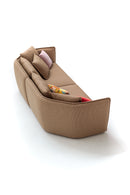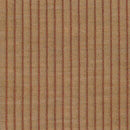Description
Seats are stress-resistant polyurethane foam in varied densities and polyester fibre on wood frame.
Terminal parts of the sides are injected flame retardant polyurethane foam.
Optional cushions are goose down or polyester fibre. All compositions include steel linking elements.
Chamfer collection covers are removable.
Note: Loose cushions are not included but available. Please contact us for more information.
Inspiration
Diagonal movement. An intuition born from carpentry terminology becomes the distinctive feature of a modular system, which is new in terms of formal construction and innovative in terms of compositional flexibility. Even though the literal interpretation of the term chamfer refers to a smooth angle created with a 45° cut through a right angle, within this sofa it expresses a twofold widening of aesthetical and functional perspective. On the outside, the chamfer softens the shape and acts as a guide, its size conferring both a spatial and an architectural value. On the inside the angle encloses and supports, favouring a versatile seating style that adapts perfectly to a residential environment as well as to public areas. Through five modules, different in length and depth, and a single junction, it is possible to imagine a multitude of combinations, from simple specular arrangements to well-structured geometrical sequences. Its trait is strongly recognizable in reference to the deconstruction executed on Lowland (2000) and the sophisticated design on Redondo and M.a.s.s.s.a.s.(2012). The term “chamfer” refers to the sloping edge architectural detail. This is the origin of the sofa shape, which characterizes all of the system’s seating elements. Versatile, flexible, and refined, these sofas welcome us in a big elegant embrace.
The new Chamfer sofa celebrates twenty years of the Moroso and Patricia Urquiola collaboration. “Discussing this anniversary with Patrizia, for our twenty-year work anniversary, we decided to work on a simplification of a series of echoes from projects done in the past, linking up for example to Redondo and other sofas which for us represented a sort of ‘cradle’ or nest. We lowered, we geometrized, we produced purer, cleaner lines and this border, this broken edge came out, this Chamfer, a word used often in architecture where, when we join two lines in a curve, we join them in a chamfer”. (Patricia Urquiola)
Designer
Design by Patricia Urquiola, 2018

Patricia Urquiola was born in Oviedo (Spain), and she lives and works in Milan. She studied Architecture at the Technical University of Madrid and at the Polytechnic University of Milan, where she graduated in 1989 under Achille Castiglioni. She was assistant lecturer for Achille Castiglioni; she worked with Vico Magistretti; and she was also Head of Design for Lissoni Associati. In 2001 she opened her own studio, working in the fields of product design, interiors and architecture. Her most recent designs include: The “Museo del Gioiello” jewellery museum in Vicenza, the Hotel Mandarin Oriental in Barcelona, the Hotel Das Stue in Berlin, the Spa of the Hotel Four Seasons in Milan; retail and display designs for Gianvito Rossi, BMW, Cassina, Ferragamo, Flos, Missoni, Molteni, Officine Panerai, H&M, Santoni and Pitti Uomo Firenze. She has created products for numerous major companies in Italy and abroad, including: Agape, Alessi, Axor-Hansgrohe, Baccarat, Boffi, Budri, De Padova, Driade, Flos, Gan, Georg Jensen, Glas Italia, Haworth, Kartell, Kvadrat, Listone Giordano, Louis Vuitton, Moroso, Mutina, Rosenthal and Verywood. Some of her products are exhibited in the great museums of art and design, including the MoMa in New York, the Musée des Arts décoratifs in Paris, the Museum of Design in Zurich, the Vitra Design Museum in Basel, the Victoria and Albert Museum in London, the Stedelijk in Amsterdam, and the Triennale in Milan. She has won numerous international accolades, including: The Medalla de Oro al Mérito en las Bellas Artes from the Spanish government; the order of Isabella the Catholic, presented to her by His Majesty King Juan Carlos I of Spain; “Designer of the decade” for the magazines Home and Häuser; “Designer of the Year” for the magazines Wallpaper, AD Spain, Elle Decor International and Architektur und Wohnen.
Pre Order Sales Conditions
Payment & Security
Your payment information is processed securely. We do not store credit card details nor have access to your credit card information.








